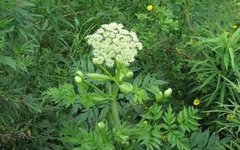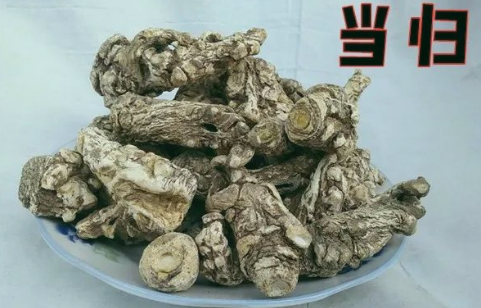
【Name】Dang Gui (Angelica Sinensis)
【Pinyin】Dānɡ Guī
【Alias】Gan Gui (as per Shennong Bencao Jing)
【Source】The root of the plant Angelica Sinensis, belonging to the Apiaceae family. It generally requires three years of cultivation before harvesting. The roots are dug up in late autumn, cleaned of stems and soil, and dried in a ventilated area for a few days. They are then bundled according to size and lightly smoked until thoroughly dried. This herb is oily, prone to mold and insect damage, and must be stored in a dry place. During moldy rainy seasons, it should be treated with sulfur or appropriately dried.
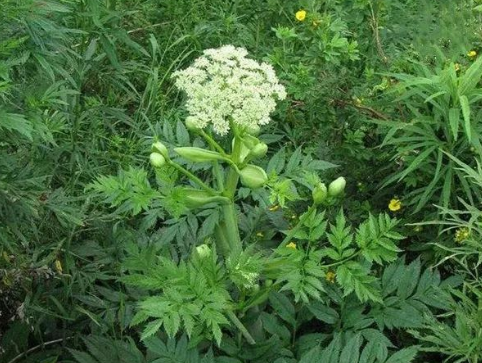
【Morphology】A perennial herb, growing to a height of 0.4 to 1 meter. The stem is erect, purple, with distinct longitudinal grooves, smooth and hairless. The leaves are 2-3 times pinnately divided, with petioles 3-11 cm long, and the basal leaf sheath is enlarged; leaflets are ovate; there are 3 pairs of small leaflets, with the pair closest to the petiole having petioles 0.5-1.5 cm long, while the pair near the apex is sessile, divided 1-2 times, with notched edges. The inflorescence is a compound umbel, terminal, with 10-14 peduncles of varying lengths, and 2 linear bracts at the base, or absent; there are 2-4 small bracts, linear; the small umbel has 12-36 flowers, with pedicels 0.3-1.5 cm long.

The flowers are densely covered with fine hairs; the calyx has 5 lobes, which are finely ovate; the petals are 5, white, and elongated ovate, with a pointed tip that slightly folds inward and is hairless; there are 5 stamens, with filaments bent inward; the ovary is inferior, with a short style and a conical base. The double-samaras are oval, 4-6 mm long and 3-4 mm wide, and easily separate at maturity; each fruit has 5 ridges, with dorsal ridges raised linearly, and lateral ridges developing into wide, thin wings with pale purple edges; the transverse section is flat on the back, with one oil duct in each groove, and two oil ducts at the junction. The flowering period is from June to July, and the fruiting period is from July to August.
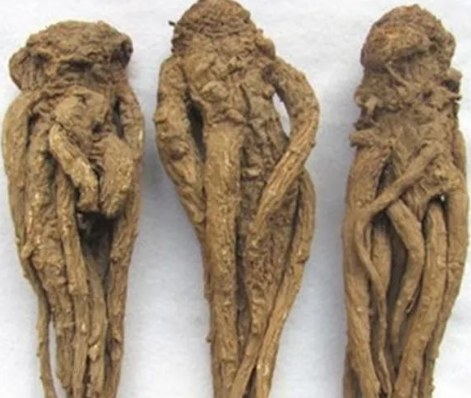
【Distribution】It is distributed in Gansu, Sichuan, Yunnan, Shaanxi, Guizhou, Hubei, and other regions. It is cultivated in various places, with the main production areas being Gansu and Yunnan. Additionally, it is also produced in Shaanxi, Sichuan, Hubei, and Guizhou.
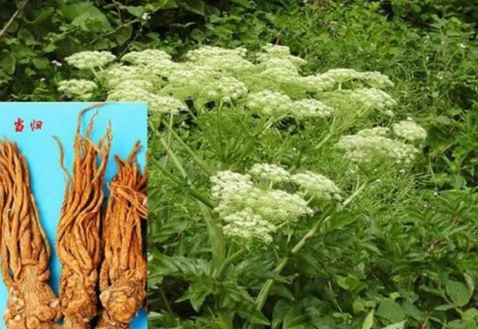
【Characteristics】The dried root can be divided into three parts: the root head is called “Gui Tou”, the main root is called “Gui Shen”, and the lateral roots and their tips are called “Gui Wei”. The total length is about 10-25 cm, with the main body length being about 3-10 cm. The diameter of the root head is 2-4 cm, and the lateral roots are 0.3-1 cm in diameter. The exterior is gray-brown or brown, with longitudinal wrinkles throughout, especially abundant at the lateral root part. The top of the root head is rounded and flat, with remnants of stems and leaves, often with inconspicuous ring-like wrinkles. The main body is slightly cylindrical,
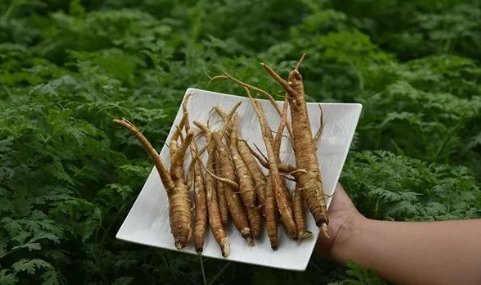
with a rough surface, and 3-5 or more “Gui Wei” growing underneath, which are thick at the top and thin at the bottom, often twisted, with small nodule-like root scars on the surface. The texture is mostly flexible, with a yellow-white cross-section that has fissures, shallow brown ring patterns in the middle layer, and numerous brown oil spots. It has a strong aromatic scent and a sweet, slightly bitter, and spicy taste. The best quality is characterized by a large main root, long body, few lateral roots, a yellow-white cross-section, and a strong aroma. Inferior quality is indicated by a small main root, many lateral roots, a weaker aroma, and a reddish-brown cross-section.

【Processing】Dang Gui: Remove impurities, wash clean, moisten, and dry slightly until the internal and external moisture is suitable, then slice and sun-dry. Wine Dang Gui: Take slices of Dang Gui, spray evenly with yellow wine, slightly moisten, and stir-fry in a pot over low heat, then remove and cool. (For every 100 jin of Dang Gui slices, use 10 jin of yellow wine) Leigong’s Theory of Processing: “For using Dang Gui, first remove dust and the hard tip, soak in wine overnight.”
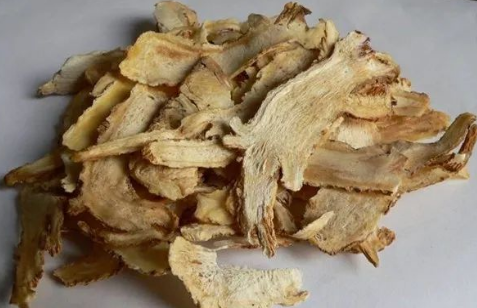
【Properties】Sweet and spicy, warm.
① Shennong Bencao Jing: “Taste is sweet, warm.”
② Wupu Bencao: “Shennong, Huangdi, Tongjun, Bian Que: sweet, non-toxic. Qibo, Leigong: spicy, non-toxic. Li’s: slightly warm.”
③ Bielu: “Spicy, very warm, non-toxic.”
④ Bencao Shuo: “Taste is bitter, warm, non-toxic.”
【Meridians Entered】Enters the Heart, Liver, and Spleen meridians.
① Tangye Bencao: “Enters the Hand Shaoyin, Foot Taiyin, and Jueyin meridians.”
② Leigong’s Theory of Medicinal Properties: “Enters the Heart, Liver, and Lung meridians.”
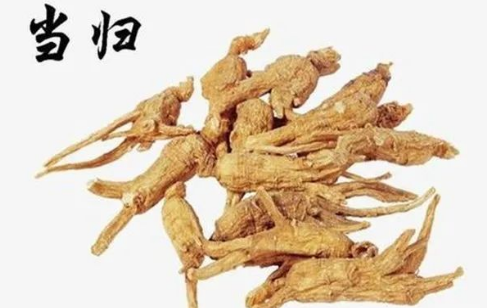
【Effects】Nourishes blood and regulates menstruation, alleviates pain, moistens dryness, and promotes bowel movement. It is used for irregular menstruation, amenorrhea with abdominal pain, masses and accumulations, metrorrhagia; blood deficiency headaches, dizziness, and atrophy; dry intestines with constipation, post-dysentery heaviness; carbuncles and sores, injuries from falls.
【Usage】For internal use: decoction, 1.5-3 qian; soaked in wine, concentrated extract, or in pills and powders.
【Precautions】Use with caution in cases of damp obstruction and diarrhea.
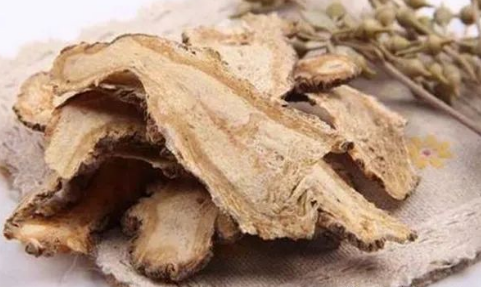
【Additional Formulas】① To regulate and nourish the Wei and Ying, and to nourish Qi and blood. For deficiency of Chong and Ren, irregular menstruation, abdominal pain, metrorrhagia, blood stasis, pain, pregnancy-related cold, and instability of fetal movement: Dang Gui (remove the fibrous parts, soak in wine, stir-fry), Chuan Xiong (Ligusticum chuanxiong), Bai Shao (White Peony), Shu Di Huang (Rehmannia glutinosa, wine-steamed) in equal parts. Grind into a coarse powder. Take 3 qian, with 1.5 cups of water, decoct until 8 parts remain, strain and take warm before meals. (From Jufang Si Wu Decoction)
② For young women with menstrual obstruction: Dang Gui (sliced and roasted) 1 liang, Gan Qi (smoked until aromatic), Chuan Xiong each 0.5 liang. Grind the three ingredients into a powder, mix with honey to form pills the size of a phoenix seed. Take 20 pills with warm wine. (From Sheng Ji Zong Lu Dang Gui Pills)
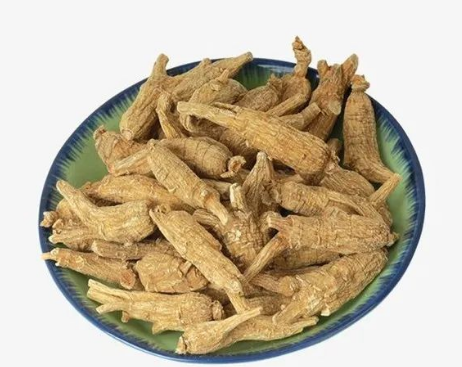
③ For menstrual flow reversing through the mouth and nose: first use ink to stop it, then use Dang Gui Wei and Hong Hua each 3 qian, with 1.5 cups of water, decoct for 8 parts, take warm. (From Jian Bian Dan Fang)
④ For blood loss: Dang Gui 1 liang, Long Gu (Dragon Bone) 2 liang (roasted red), Xiang Fu Zi (Cyperus rotundus) 3 qian (roasted), Song Mao Hui 5 qian. Grind into a powder, mix with rice wine 3-4 qian, take on an empty stomach. (From Rumen Shiqin Dang Gui Powder)
⑤ For blood stasis pain and distension, with a stasis pulse: Dang Gui 3 liang, Gui Xin (Cinnamon) 2.5 liang, Bai Shao 2.5 liang (roasted in wine), Pu Huang 2 liang (roasted), Xue Jie 3 liang, Yan Hu Suo 2.5 liang. Grind into a powder, decoct 3 qian in wine, strain and take warm. (From Yilue Liushu Dang Gui Pu Yan Powder)
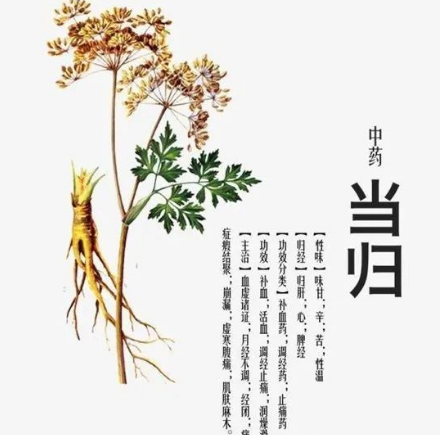
⑥ For women with leukorrhea of five colors, abdominal pain, emaciation, and poor appetite: Dang Gui 1 liang (chopped and lightly roasted), Bie Jia (Tortoise Shell) 1 liang (vinegar-roasted until slightly yellow, remove the skirt), Chuan Da Huang 1 liang (chopped and lightly roasted), Bai Zhu 3 fen, Hu Jiao 0.5 liang, He Li Le Pi 3 fen, Bin Lang 3 fen, Zhi Qiao 3 fen (roasted until slightly yellow and remove the pulp), Bi Bo 0.5 liang. Grind the above ingredients into a powder, mix with honey and form pills the size of a phoenix seed, take 30 pills with warm wine before meals. (From Sheng Hui Fang Dang Gui Pills)
⑦ For women during pregnancy with abdominal pain: Dang Gui 3 liang, Bai Shao 1 jin, Fu Ling 4 liang, Bai Zhu 4 liang, Zexie 0.5 jin, Chuan Xiong 0.5 jin (0.5 jin can also be 3 liang). Grind into a powder, take with wine three times a day. (From Jin Kui Yao Lue Dang Gui Bai Shao Powder)
⑧ For difficulty in urination during pregnancy, with normal appetite: Dang Gui, Bei Mu (Fritillaria), Ku Shen each 4 liang. Grind the three ingredients into a powder, mix with honey to form pills the size of a small bean, take 3 pills, increasing to 10 pills. (From Jin Kui Yao Lue Dang Gui Ku Shen Pills)

⑨ For fetal movement instability during pregnancy, with abdominal pain: Dang Gui 0.5 liang (chopped), Cong Bai 1 fen (finely chopped). Combine the two ingredients, first decoct with 3 cups of water until reduced to 2 cups, add good wine 1 cup, and decoct for several more boils, strain and divide into three doses. (From Sheng Ji Zong Lu An Tai Drink)
⑩ For postpartum blood that does not disperse, forming lumps (commonly referred to as child pillow), with unbearable pain: Dang Gui 1 liang (chopped and lightly roasted), Gui Jian Yu 1 liang, Hong Hua 1 liang. Grind the herbs into a powder, take 3 qian with 1 cup of wine, decoct until reduced to 6 parts, strain and take warm, regardless of time. (From Sheng Hui Fang Dang Gui Powder)
⑪ For tremors, or postpartum unconsciousness, with phlegm and saliva: Dang Gui, Jing Jie Sui in equal parts. Grind into a fine powder, take 3 qian with 1 cup of water and a little wine, decoct until reduced to 7 parts, and administer. (From Fu Ren Liang Fang Jiao Jia Powder)
⑫ For postpartum abdominal pain, and abdominal cold hernia with deficiency and fatigue: Dang Gui 3 liang, Sheng Jiang 5 liang, Yang Rou 1 jin. Combine the three ingredients, boil with 8 liters of water, and take 7 cups warm, three times a day. (From Jin Kui Yao Lue Dang Gui Sheng Jiang Yang Rou Soup)
Above content is extracted from the internet, with gratitude to the original author!


